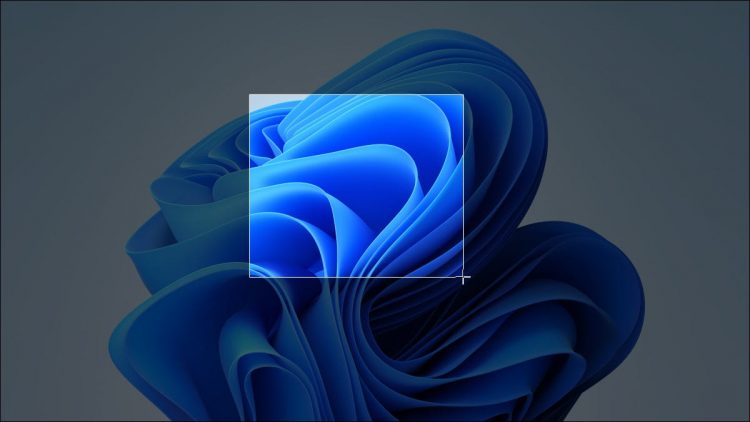Press Windows+Print Screen to instantly take a fullscreen screenshot on Windows 11. The screenshot will be saved to C:Users[User Name]PicturesScreenshots. Press Windows+Shift+S to open Snip and Sketch and capture screenshots of a specific region or window or take a freeform screenshot.
If you need to capture the contents of your Windows 11 PC’s screen (or a portion of it) for later reference, then it’s time to take a screenshot. You can use built-in screenshot features or third-party tools. Here are several different ways to do it.
Copy the Entire Screen to the Clipboard: Press Print Screen
In Windows 11, as in previous versions of Windows, you can copy an image of your entire screen into the clipboard (a temporary storage area for copying and pasting) by pressing the Print Screen (PrtScn) key. Sometimes, the Print Screen key will be labeled “PrtScn” or “PrtScrn” on your keyboard.
On desktop keyboards, you’ll usually find the Print Screen key to the right of the F12 key, along the topmost row of keys. On laptop keyboards, you might need to press a function (“Fn”) key while pressing the Print Screen key to make it work.
With a screenshot in your clipboard, you can paste the screenshot into any application that can receive pasted images. For example, you can open the Paint app that comes with Windows and paste the image with Ctrl+V. Then press Ctrl+S to save the screenshot as a file in your desired image format.
RELATED: How to Copy, Cut, and Paste on Windows 10 and 11
Save a Screenshot as a File: Press Windows+Print Screen
If you’d like to instantly save a screenshot as an image file on your PC, press Windows+Print Screen on your keyboard. Windows will take a full-screen screenshot and automatically save it as a PNG file named “Screenshot (#).png” in the C:Users[User Name]PicturesScreenshots folder (where “#” is a number that counts up over time based on the number of screenshots you’ve taken).
And remember that if you have a laptop, you might need to hold the Function or “Fn” key while pressing Print Screen or “PrtSc” for it to work, so you might need to press Windows+Fn+Print Screen to capture your screen as a PNG file.
RELATED: What’s the Difference Between JPG, PNG, and GIF?
Copy the Active Window to the Clipboard: Press Alt+Print Screen
If you’d like to capture the currently active window to the clipboard (without having to select it or crop an image), press Alt+Print Screen on your keyboard. Once in the clipboard, you can paste the screenshot into any app that will receive images, like Microsoft Paint, Adobe Photoshop, or a free image editing app like Paint.NET.
RELATED: Paint.NET is a Quality Photo Editing App for Windows
Capture a Portion of the Screen to the Clipboard: Press Windows+Shift+S
If you’d like to capture a specific portion of your screen that you select yourself, you can use a special Windows 11 screen snipping tool. At any time, press Shift+Windows+s on your keyboard. The screen will darken, and you’ll see a small toolbar at the top center of the screen. From left to right, here’s what the options do:
- Rectangular Snip: Select a rectangle-shaped free-form area of the screen to capture.
- Freeform Snip: Select an irregular shape as a screenshot. The area around the irregular shape (in the rectangular image) will be black when you paste it.
- Window Snip: Choose an application window and capture just that window.
- Full-screen Snip: Similar to pressing Print Screen by itself, this option captures a screenshot of your entire screen.
To capture a rectangular selection of the screen, for example, click the leftmost icon on the toolbar, which looks like a rectangle with a plus in the corner.

Next, position your cursor near what you’d like to capture. Click and hold the mouse button, then drag your mouse (or finger on a trackpad) until you’ve selected the rectangular area you want to save.

When you release your mouse button, the area you selected will be copied to the clipboard. If you have notifications turned on, you’ll see a small pop-up in the corner of the screen from Snipping Tool. If you click it, the screenshot you just took will open in the Snipping Tool app where you can annotate, crop, or save it as necessary (see the section below).

If you ignore the pop-up notification, you’ll still need to paste the screenshot into an image editing program such as Microsoft Paint to be able to save it to a file. However, you can also paste the image directly into other applications, such as email clients and messaging apps.
RELATED: Microsoft Paints Paint With a Fresh Coat of Paint in Windows 11
Use Print Screen to Open Screen Snipping
Windows 11 includes a handy option that will allow you to launch the screen snipping tool (seen in the last section) by pressing Print Screen instead of having to press Windows+Shift+S. To enable it, open Windows Settings by pressing Windows+i. Then navigate to Accessibility > Keyboard. Scroll down and flip the switch beside “Use the Print Screen button to open screen snipping” to “On.”

After that, close settings. Any time you want to open the screen snipping tool to quickly copy screenshots to the clipboard, just press Print Screen on your keyboard.
Take a Screenshot on a Device Without a Print Screen Key
 Microsoft
Microsoft
On some older Windows devices that lack a Print Screen key (such as early Microsoft Surface tablets), you can take a screenshot by pressing Windows+Fn+Spacebar.
Alternately, if you have a tablet or other device with a Windows logo button, you can press the Windows button and the Volume Down button at the same time to capture the entire screen. Either method will save a screenshot to the PicturesScreenshots folder in your user folder.
RELATED: How to Take a Screenshot on Almost Any Device
Take a Screenshot Using Snipping Tool
To take screenshots with more control that you can annotate, save, or share, you can use Windows 11’s Snipping Tool. To launch it, open the Start menu and type “snipping,” then click the Snipping Tool icon when you see it.

When the Snipping Tool opens, click “New” to start a new capture.

Once you do, you’ll see a small toolbar at the top of the screen (like the one seen in the “Capture a Portion of the Screen” section above) that allows you to perform a rectangular snip, freeform snip, window snip, and full-screen snip. The difference here is that with the Snipping Tool app running, these tools don’t just copy the screenshot to the clipboard. Instead, you can save them to a file.

After capturing the screenshot using one of the methods in the toolbar, it will appear in the Snipping Tool window. You’ll have the opportunity to crop it, annotate it with a drawing pen, save it as a file, or share it with others using the toolbar at the top of the window.

Also, if you need to capture something with a timed delay, Snipping Tool is ideal. Click the clock icon in the toolbar and select a delay time in the drop-down menu that appears.

After selecting the time, click the “New” button, and a screenshot will trigger after the time period you selected. To save the file, click the floppy disk save icon on the toolbar and choose a location. Nice and easy!
RELATED: Windows 11’s Redesigned Snipping Tool Looks Awesome
Take a Screenshot (or Video) With the Xbox Game Bar
You can also take a screenshot or capture a video using the Xbox Game Bar. To do so, first, open the Xbox Game Bar by pressing Windows+g on your keyboard (or you can hit the Xbox logo button on a connected Xbox controller). Once it appears, you can use the “Capture” widget to capture screenshots in PNG format and videos in MP4 format.
If you don’t see the “Capture” window on the Xbox Game Bar screen, click the “Widgets” button in the toolbar at the top of the screen and select “Capture.”

In the “Capture” window (which appears in the upper left corner of the screen by default), click the camera icon to take a screenshot of the current app (or desktop, if no app is active).

Similarly, to record a video of the currently active app, click the record button (which looks like a small white dot inside the larger grey button circle. Note that, for some reason, Windows 11 will not let you take a video of File Explorer or the desktop, only an active app.

To stop recording, click the square “Stop” button in the Xbox Game Bar floating toolbar, or within the Xbox Game Bar Capture widget.
After capturing, the screenshots and videos will appear in your C:Users[username]VideosCaptures folder. You can also review them in the “Gallery” widget within the Xbox Game Bar interface itself. When you’re done capturing, click any blank area of the screen or hit escape to close the Xbox Game Bar.
RELATED: 6 Great Features in Windows 10’s New Game Bar
Use a Third-Party Screenshot Utility

Although the Windows operating system (OS) contains its own screenshot capabilities (as you’ve seen above), you can gain new features and flexibility by installing a third-party screenshot program.
Among the dozens of free screenshot apps available for Windows, we recommend Greenshot as a good starting point. It’s free, and it includes different capture and output options for several different screenshot keyboard shortcuts.
If you want something even more powerful and you don’t mind spending a few dollars on quality software, we recommend SnagIt by Techsmith. Many of us here at How-To Geek have used it for years. It’s a feature-filled application that makes taking great screenshots easy (it can capture videos and animated GIFs, too.)
SnagIt offers a free trial, so we recommend you give it a try and see whether it meets your needs. If you take a lot of screenshots, it might make your life significantly easier.
Source by www.howtogeek.com






























